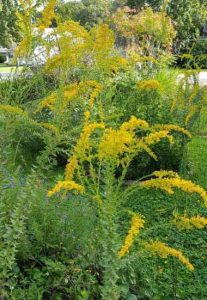
Goldenrod is a showy, native Florida wildflower that is worth planting in your landscape, pollinator garden, or food forest. Goldenrod is often incorrectly blamed for people’s allergies, but it’s pollen is too heavy to be blown in the wind, so unless you directly sniff a goldenrod flower, you won’t be breathing the pollen in the air.
The scientific name of goldenrod, Solidago means “to make whole” in Latin, referring to the plant’s healing properties. Goldenrod contains antioxidants and compounds that inhibit bacteria, fungus and inflammation, and is even being studied for it’s potential cancer-fighting properties. Native Americans and European immigrants to North America historically used goldenrod ointments and poultices for wounds. They also used the flowers and leaves to make tea for an enjoyable beverage and to remedy a variety of ailments. While all goldenrod species are non-toxic, Sweet Goldenrod (Solidago odora variety odora), with it’s licorice-flavored leaves, is popular for tea. Jelly can also be made from goldenrod flower tea. Goldenrod has also been used to make perfume, fabric dye, and even rubber.
Goldenrod flowers are an excellent nectar and pollen source for numerous pollinating insects, like honey bees, that pollinate our food crops. Goldenrod is a significant honey plant in Florida and many other states. Honey made from goldenrod nectar has a notoriously unpleasant scent, but the flavor is delicious, rich, and spicy. The honey is prized by makers of mead (honey wine). Once goldenrod is finished blooming, small songbirds eat the dried seeds from the plant, and native bees nest in the hollow stems.
Goldenrod is a perennial, blooming in fall, dying back in winter, and regrowing in spring. Goldenrods prefer full sun, but each species has specific soil and moisture conditions that it prefers. In a maintained landscape, Wand Goldenrod (Solidago stricta) is a good selection. Chapman’s Goldenrod (Solidago odora var. chapmanii) is a clumping species that won’t overtake your landscape bed, but it may need to be staked up to prevent the 5 ft. tall flower stalks from flopping over. Many species of native Florida goldenrod could successfully grow in Osceola County, and if you’re planting a naturalistic wildflower meadow, species that spread more readily or have sprawling forms can also be used.
You can find goldenrod at native plant nurseries, the Florida Wildflower Foundation, and Florida Native Plant Society events.
For classes and information on Florida landscaping or farming, contact the UF IFAS Extension-Osceola County: 321-697-3000.
 4
4
